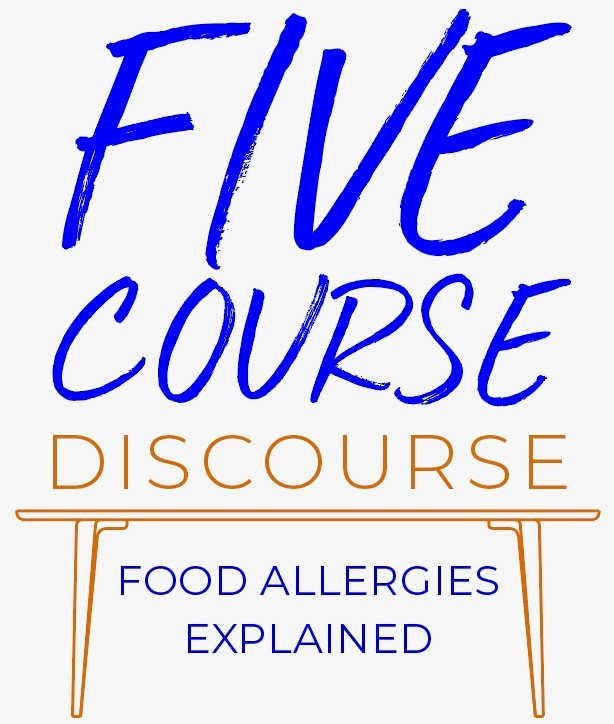
When hosting a dinner party there are many things to keep in mind. Location, date, who to invite and how to distribute the invitations. However, the most important item on the party list is the menu. The menu can make or break the success of any dinner party. With so many dietary issues, allergies and health concerns it’s tough to decide what to include on the carte du jour. The purpose of this blog is to help you host a successful dinner party that will keep food allergies at bay. Posts one and two will cover “Food Allergy Basics” while posts three, four and five will tackle a specific course from the menu. All posts will provide helpful tips regarding food allergies, what are the most prevalent allergies, signs of an allergic reaction and what does it mean to be “free” as in gluten free and diary free. The three meal course posts will cover salads and appetizers, the main course and finally desserts. Now that we have a plan let’s get the Five Course Discourse started.
Blog Post #1: Foundation of Food Allergies
What is a food allergy?
According to the Mayo Clinic, a food allergy is a reaction from our immune system after consuming any (even a tiny amount) quantity of a particular food. This reaction occurs within minutes to a few hours and can include digestive problems such as abdominal pains, diarrhea, nausea and vomiting, as well as hives, itching, swelling of lips, face, tongue and throat and wheezing, nasal congestion and dizziness/fainting (“Food allergy – Symptoms and causes,” n.d.). Three percent of all adults are affected by food allergies and some have severe reactions known as anaphylaxis.
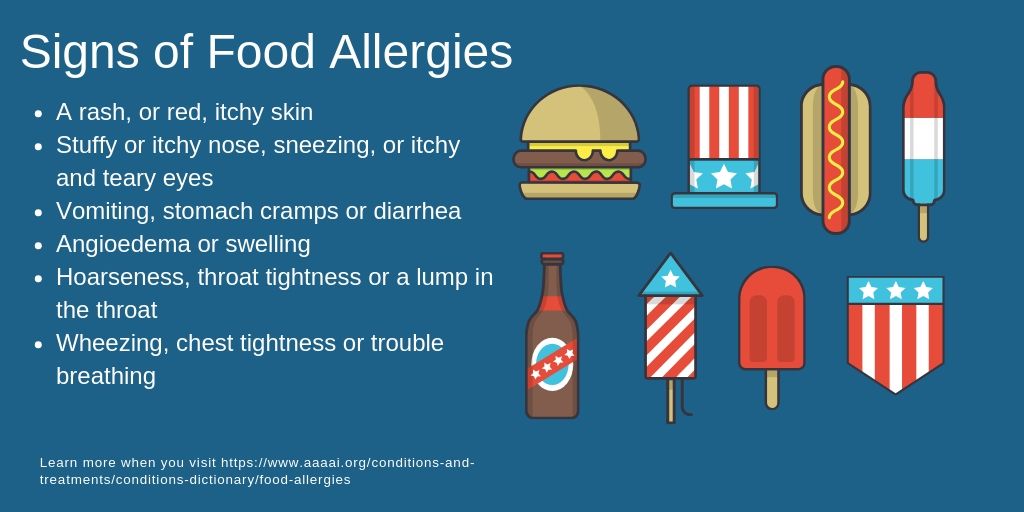
What Is Anaphylaxis?
The most dangerous and possibly life-threatening allergic reaction is anaphylaxis (an-a-fil-LAX-is). Anaphylaxis is a severe allergic reaction that occurs quickly and may be fatal. Anaphylaxis can affect multiple body parts at the same time (“Anaphylaxis | AAAAI,” n.d.). This serious reaction can make it hard to breathe and may reduce circulation thus requiring immediate and emergency medical treatment. The first-line treatment for anaphylaxis is a medicine called epinephrine (“Newly Diagnosed Packet | Food Allergy Research & Education,” n.d.). FARE (Food Allergy Research & Education) provides a plethora or resources on Anaphylaxis such as Epinephrine Assistance Resources, Access to Epinephrine and an Emergency Plan (“Anaphylaxis | Food Allergy Research & Education,” n.d.). To find the FARE popular resources visit, https://www.foodallergy.org/life-with-food-allergies/anaphylaxis.
Food Allergy & Anaphylaxis Connection Team (FAACT) Anaphylaxis Signs and Symptoms:
- Mouth: itching, tingling and swelling of the tongue/lips/ palate
- Throat: hoarseness, tightening, difficulty swallowing, hacking, coughing
- Lungs: shortness of breath, wheezing, coughing, chest pain, tightness
- Gut: abdominal pain, nausea, vomiting, diarrhea
- Brain: anxiety, panic, sense of doom
- Eyes/Nose: runny nose, sneezing, watery eyes, itching eyes, swollen eyes
- Skin: hives, rash, redness, itching, swelling
- Circulation/Heart: chest pain, low blood pressure, weak pulse, shock, pale blue color, dizziness, lethargy. (“Food Allergy & Anaphylaxis | Anaphylaxis | Anaphylaxis,” n.d.)
FAACT recommends an immediate call to 9-1-1 if someone is experiencing an allergic reaction.
Sources:
Anaphylaxis | AAAAI. (n.d.). Retrieved July 3, 2019, from The American Academy of Allergy, Asthma & Immunology website: https://www.aaaai.org/conditions-and-treatments/allergies/anaphylaxis
Anaphylaxis | Food Allergy Research & Education. (n.d.). Retrieved July 3, 2019, from /life-with-food-allergies/anaphylaxis
Food Allergy & Anaphylaxis | Anaphylaxis | Anaphylaxis. (n.d.). Retrieved June 25, 2019, from https://www.foodallergyawareness.org/food-allergy-and-anaphylaxis/anaphylaxis/anaphylaxis/
Food allergy – Symptoms and causes. (n.d.). Retrieved June 25, 2019, from Mayo Clinic website: https://www.mayoclinic.org/diseases-conditions/food-allergy/symptoms-causes/syc-20355095
Newly Diagnosed Packet | Food Allergy Research & Education. (n.d.). Retrieved July 3, 2019, from /life-with-food-allergies/newly-diagnosed/newly-diagnosed-packet
Blog Post #2: Feeling Sensitive?
According to the Cleveland Clinic “food allergies affect about 1 percent of adults and 7 percent of children, although some children outgrow their allergies. Food intolerances are much more common. In fact, nearly everyone at one time has had an unpleasant reaction to something they ate. Some people have specific food intolerances, such as lactose intolerance which affects 10% of the population (“Food Allergy vs Food Intolerance | Cleveland Clinic,” n.d.).” If you have a reaction every time you consume even a small amount of food then you may have a food allergy. You should try to avoid consuming those particular foods that cause the reaction. If you eat a certain food often or eat a large amount, then have symptoms this is likely a food intolerance. Intolerances are dose or quantity related.
In order to determine if you have a food allergy your primary care provider would likely refer you to an allergist for food allergy testing. These tests can include an Oral Challenge, Elimination Diet, Skin Prick and/or a Blood Test. The allergist will also be able to diagnosis a food allergy and/or a food sensitivity. A food sensitivity aka food intolerance is less severe than an allergy and occurs when your body fails to digest certain foods properly. The symptoms of a food intolerance include gas, diarrhea, nausea and abdominal pain. The infographic below demonstrates the difference between food allergy versus food intolerance symptoms.

Common Causes of Food Sensitivities
- Lactose – this is the sugar that is in milk. Those that have a lactose intolerance don’t produce enough lactase (enzyme that breaks down milk sugar) and are not able to process milk sugar.
- Monosodium glutamate (MSG)– an additive and flavor enhancer found in restaurant and packaged food. This is also known as “Chinese Restaurant Syndrome.”
- Gluten – a protein found in grain such as wheat or barley (“Food Allergy Testing,” n.d.).
Recently Diagnosed Food Allergy, Now What?
Once you have been diagnosed with a food allergy, there are multiple questions that you may have to better understand and manage your allergy. FARE (Food Allergy Research and Education) has created Your Food Allergy Field Guide (2018). This informational packet can be found on the FARE website, foodallergy.org/sites/default/files/migrated-files/file/field-guide.pdf and provides information on the following topics:
- A Checklist for Getting Started
- Managing Food Allergies: What You Need to Know
- Food Allergy & Anaphylaxis Emergency Care Plan
- Understanding Food Labels
- Tips for Avoiding Your Allergen
- How to Avoid Cross-Contact
- Dining Out with Food Allergies
- Preparing Others to Care for Children with Food Allergies
- Food Allergies: Frequently Asked Questions (“Newly Diagnosed Packet | Food Allergy Research & Education,” n.d.)
Sources:
Food Allergy Testing: MedlinePlus Lab Test Information. (n.d.). Retrieved June 25, 2019, from https://medlineplus.gov/lab-tests/food-allergy-testing/
Food Allergy vs Food Intolerance | Cleveland Clinic. (n.d.). Retrieved July 14, 2019, from https://my.clevelandclinic.org/health/diseases/10009-food-problems-is-it-an-allergy-or-intolerance
Newly Diagnosed Packet | Food Allergy Research & Education. (n.d.). Retrieved July 3, 2019, from /life-with-food-allergies/newly-diagnosed/newly-diagnosed-packet
Blog Post #3: For Starters (Salads and Appetizers)
According to the FDA (2019), 90 percent of food allergic reactions are caused by eight foods. In order to help the food allergy population to identify these foods quickly and easily the US Congress passed a federal law in 2004, with guidance from the FDA, governing how allergens are labeled on packaged food. This law was known as FALCPA, The Food Allergen Labeling and Consumer Protection Act. FALCPA took effect January 1, 2006 (“Food Allergen Labeling and Consumer Protection Act (FALCPA) | Food Allergy Research & Education,” n.d.; Nutrition, 2019). FALCPA requires food labels to identify and list these eight items if any amount is present. To learn more about FALPA, visit the FDA website, https://www.fda.gov/food/food-allergens-and-gluten-free-guidance-documents-and-regulatory-information/food-allergen-labeling-and-consumer-protection-act-2004-questions-and-answers.
The graphic below lists the eight foods that required to be listed on processed food labels.
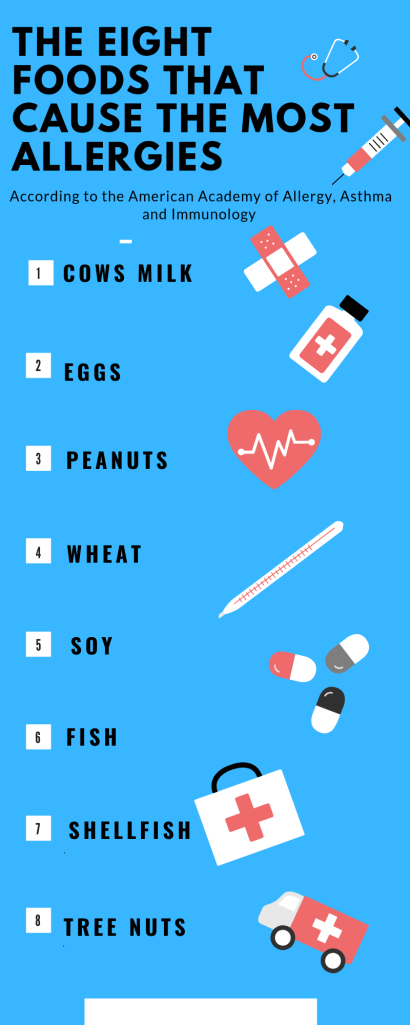
Five Course Discourse Discussion:
This blog post will tackle two of the big eight food allergies; egg and peanut allergies. When preparing the salad and/or appetizer course of the meal being thoughtful and aware of potential guests’ allergies is one key to a successful dinner party. For instance, be cautious of eggs in salads. People with egg allergies can be allergic to chicken, goose, duck, turkey or quail eggs. Sometimes people can tolerate eggs on baked goods as well as food prepared at high temperatures for long periods of time. But when preparing the meal for your guests its best to avoid eggs altogether.
When creating your menu its best to avoid any and all things peanut. Peanuts are the one of food allergen that cause the most cases of anaphylaxis (“Peanut Allergy,” 2015). According to the American College of Allergy, Asthma & Immunology, a peanut is a legume (belonging to the same family as soybeans, peas and lentils), not a tree nut and are commonly found in candies, cereals and baked goods. When eating out, check with the chef regarding ingredients especially when eating Asian or Mexican food, as peanuts are often used in sauces and marinades. Additionally, be cautious of the possibility of cross contamination, such as the use of utensils that may have touched a peanut product being used universally at a restaurant. When cooking at home modify recipes to remove peanut ingredients, this could include substituting ingredients like toasted oats, raisins or seeds when peanuts are recommended (“Peanut Allergy,” 2015).
Egg-cellent Fun Fact
In order to test for an egg allergy an allergist will conduct a skin prick test that includes an injection of a small amount of liquid egg protein in the forearm or the back. A small sterile probe is used which allows the skin to have the liquid soak into it. After 15 – 20 minutes if a raised, reddish spot forms then an allergy may be present. The liquid used in the test contains a protein that will help diagnosis if a person has an allergy to egg white proteins (more common) or eqq yolk proteins. (“Egg Allergy,” 2015).
Sources:
Egg Allergy. (2015, January 12). Retrieved July 14, 2019, from ACAAI Public Websi: https://acaai.org/allergies/types-allergies/food-allergy/types-food-allergy/egg-allergy
Food Allergen Labeling and Consumer Protection Act of 2004 (FALCPA) | FDA. (n.d.). Retrieved July 14, 2019, from https://www.fda.gov/food/food-allergens-and-gluten-free-guidance-documents-and-regulatory-information/food-allergen-labeling-and-consumer-protection-act-2004-falcpa
Nutrition, C. for F. S. and A. (2019). Food Allergen Labeling And Consumer Protection Act of 2004 Questions and Answers. FDA. Retrieved from http://www.fda.gov/food/food-allergens-and-gluten-free-guidance-documents-and-regulatory-information/food-allergen-labeling-and-consumer-protection-act-2004-questions-and-answers
Peanut Allergy. (2015, January 12). Retrieved July 15, 2019, from ACAAI Public Website: https://acaai.org/allergies/types/food-allergies/types-food-allergy/peanut-allergy
Blog Post # 4: Glutton for Gluten
Another member of the eight major food allergies that must be listed on packaged foods sold in the United States is WHEAT. Wheat is the most common grain in the United States. When a person experiences a wheat allergy, B-cells, a type of white blood cell, signals immunoglobin E or IgE antibodies to fight the wheat (“Celiac Disease, Non-Celiac Gluten Sensitivity or Wheat Allergy,” n.d.). Concurrently, the bodies tissues send a chemical to alert the body that there is a problem. That alert or reaction happens quickly, thus requiring the person to avoid eating any type of wheat (“Celiac Disease, Non-Celiac Gluten Sensitivity or Wheat Allergy,” n.d.). In summary, the primary wheat allergy reaction is triggered when the allergen comes into contact with the intestinal mucosa (“Wheat Allergy,” n.d.).
A protein found in grains like wheat, barley and rye is gluten. A person with a “gluten allergy” is not the same as a person that’s allergic to wheat (“Wheat Allergy,” 2015). This may be confusing to some so let’s break it down to make things easy to understand.
Gluten Fun Facts
- Gluten allergies DO NOT exist. People have allergies to wheat and a protein found in wheat is gluten.
- A person with a wheat allergy must avoid eating any form of wheat, but does not have trouble tolerating gluten from non-wheat sources (“Celiac Disease, Non-Celiac Gluten Sensitivity or Wheat Allergy,” n.d.)
- Celiac Disease is an immune reaction to eating gluten (a protein found in wheat) and can be a very serious health threat(“Wheat Allergy,” 2015).
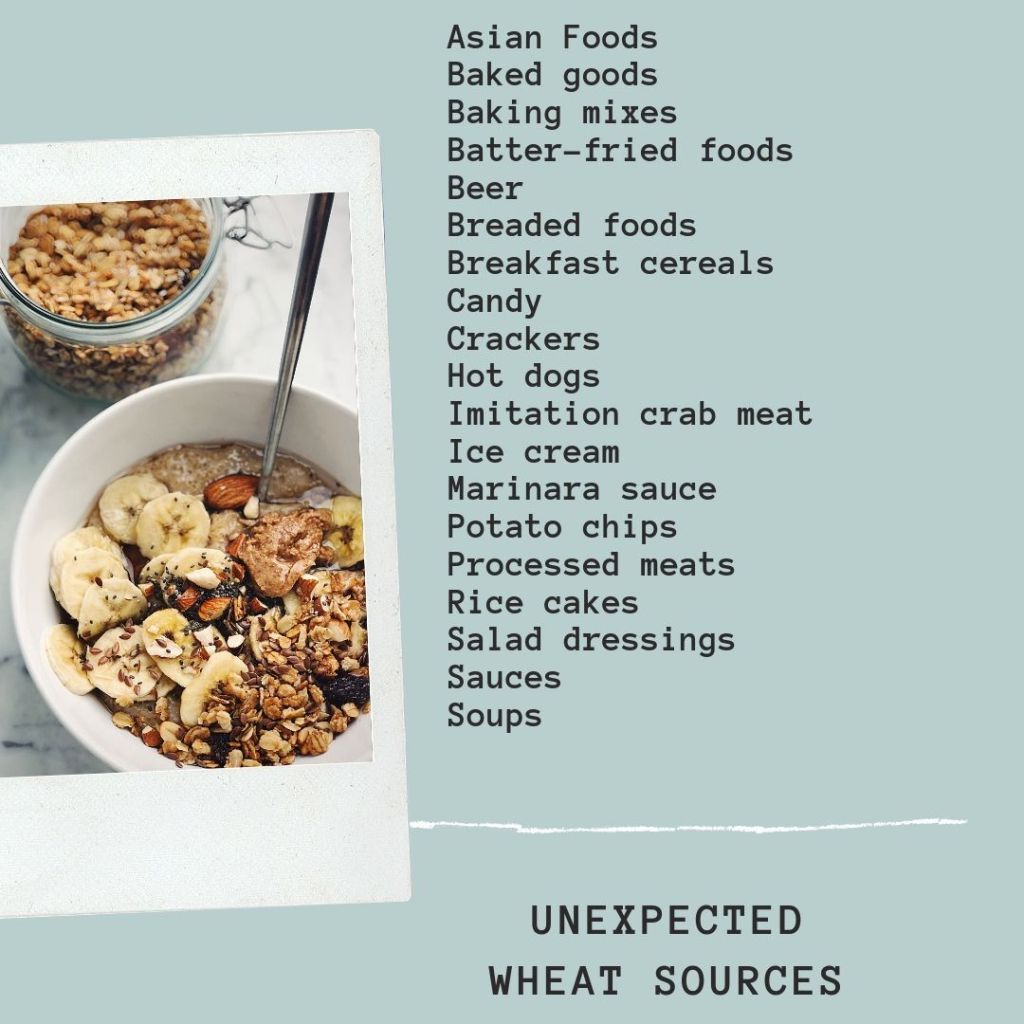
Celiac disease is a “serious autoimmune disease that damages villi of the small intestine and interferes with absorption of nutrients from food (“Celiac Disease,” n.d.).” According to the National Institute of Diabetes and Digestive and Kidney Diseases, Celiac disease is triggered by eating foods containing gluten. Gluten is a protein found naturally in wheat, barley, and rye, and is common in foods such as bread, pasta, cookies, and cakes. Many pre-packaged foods, lip balms and lipsticks, hair and skin products, toothpastes, vitamin and nutrient supplements, and, rarely, medicines, contain gluten (“Definition & Facts for Celiac Disease | NIDDK,” n.d.)..
Celiac Disease Statistics (“Celiac Disease,” n.d.)
- Approximately 1% of the population, 1 in 133 Americans or approximately 3 million people, has Celiac disease and it affects men and women of all ages.
- On average it takes six to ten years for a person to be correctly diagnosed with Celiac disease
- A person with an immediate family member that has Celiac disease is 5-22% likely to also have Celiac disease.
- Zero pharmaceutical treatments exist for Celiac disease; the only current treatment is a gluten free diet.
Five Course Discourse Suggestion
When creating your main course there are multiple options other than wheat for those who are allergic or have Celiac disease. Try substituting wheat for grains such as amaranth, barley, corn, oat, quinoa, rice, rye and tapioca (“Wheat Allergy | Food Allergy Research & Education,” n.d.). The Mayo Clinic has suggestions on gluten free diets. This information can be found by visiting, https://www.mayoclinic.org/healthy-lifestyle/nutrition-and-healthy-eating/in-depth/gluten-free-diet/art-20048530. This list of foods will also help when creating your meal for your upcoming dinner parties.
Sources:
Celiac Disease: Fast Facts | BeyondCeliac.org. (n.d.). Retrieved July 17, 2019, from Beyond Celiac website: https://www.beyondceliac.org/celiac-disease/facts-and-figures/
Celiac Disease, Non-Celiac Gluten Sensitivity or Wheat Allergy: What is the Difference? (n.d.). Retrieved July 17, 2019, from The Gluten Intolerance Group of North America website: https://gluten.org/resources/getting-started/celiac-disease-non-celiac-sensitivity-or-wheat-allergy-what-is-the-difference/
Definition & Facts for Celiac Disease | NIDDK. (n.d.). Retrieved July 16, 2019, from National Institute of Diabetes and Digestive and Kidney Diseases website: https://www.niddk.nih.gov/health-information/digestive-diseases/celiac-disease/definition-facts
Wheat Allergy. (2015, January 12). Retrieved July 16, 2019, from ACAAI Public Website: https://acaai.org/allergies/types/food-allergies/types-food-allergy/wheat-gluten-allergy
Wheat Allergy | Food Allergy Research & Education. (n.d.). Retrieved July 16, 2019, from /common-allergens/wheat-allergy
Blog Post #5: Milking It!
This Five Course Discourse post will focus on the final portion of the meal, desserts. Since milk can be found in several dessert options this post will focus on this allergy. Per US federal law, milk is one of the eight major allergen that MUST be listed on packaged foods sold (“Milk Allergy | Food Allergy Research & Education,” n.d.). The other seven allergens are included in Blog Post #3.
Milk Allergies Overview
When your body’s immune system has an abnormal response to milk and products containing milk you are likely to have a milk allergy. Milk is one of the most common allergies among children. The reaction can come from a cow as well as a sheep, goat, buffalo and other mammals’ milk (“Milk Allergy | Food Allergy Research & Education,” n.d.; “Milk allergy – Symptoms and causes,” n.d.). The Mayo Clinic has provided the following symptoms of a milk allergy.
The abrupt signs include:
- Hives
- Wheezing
- Itching or tingling feeling around the lips or mouth
- Swelling of the lips, tongue or throat
- Coughing or shortness of breath
- Vomiting
Symptoms that take longer to arise include:
- Loose stools or diarrhea, which may contain blood
- Abdominal cramps
- Runny nose
- Watery eyes
- Colic, in babies (“Milk allergy – Symptoms and causes,” n.d.)
Foods to Avoid
Two proteins that cause most of the allergic reactions found in cow’s milk are casein, found in the solid part that curdles, and whey, found in the liquid part of milk. A person can be allergic to one or both of these proteins. Casein makes up about 80 percent of milk protein, while whey makes up the remaining 20 percent (“Milk & Dairy Allergy,” 2015). Milk proteins can be tricky to find but it is included in all dairy product as well as other foods that one would not expect to contain milk. FARE (Food Allergy Research and Education) has provided the following foods to avoid if you have a milk allergy.
Avoid foods that contain milk or any of these ingredients:
- Butter, butter fat, butter oil, butter acid, butter ester(s)
- Buttermilk
- Casein
- Casein hydrolysate
- Caseinates (in all forms)
- Cheese
- Cottage cheese
- Cream
- Curds
- Custard
- Diacetyl
- Ghee
- Half-and-half
- Lactalbumin, lactalbumin phosphate
- Lactoferrin
- Lactose
- Lactulose
- Milk (in all forms including condensed, derivative, dry, evaporated, goat’s milk and milk from other animals, low-fat, malted, milkfat, non-fat, powder, protein, skimmed, solids, whole)
- Milk protein hydrolysate
- Pudding
- Recaldent(R)
- Sour cream, sour cream solids
- Sour milk solids
- Tagatose
- Whey (in all forms)
- Whey protein hydrolysate
- Yogurt
Other Possible Sources That May Contain Milk:
- Artificial butter flavor
- Baked goods
- Caramel candies
- Chocolate
- Lactic acid starter culture and other bacterial cultures
- Luncheon meat, hot dogs and sausages, which may use the milk protein casein as a binder. Also, deli meat slicers are often used for both meat and cheese products, leading to cross-contact.
- Margarine
- Nisin
- Non-dairy products, as many contain casein
- Nougat
- Shellfish is sometimes dipped in milk to reduce the fishy odor.
- Tuna fish, as some brands contain casein
- Some specialty products made with milk substitutes (i.e., soy-, nut- or rice-based dairy products) are manufactured on equipment shared with milk.
- Many restaurants put butter on grilled steaks to add extra flavor.
- Some medications contain milk protein (“Milk Allergy | Food Allergy Research & Education,” n.d.).
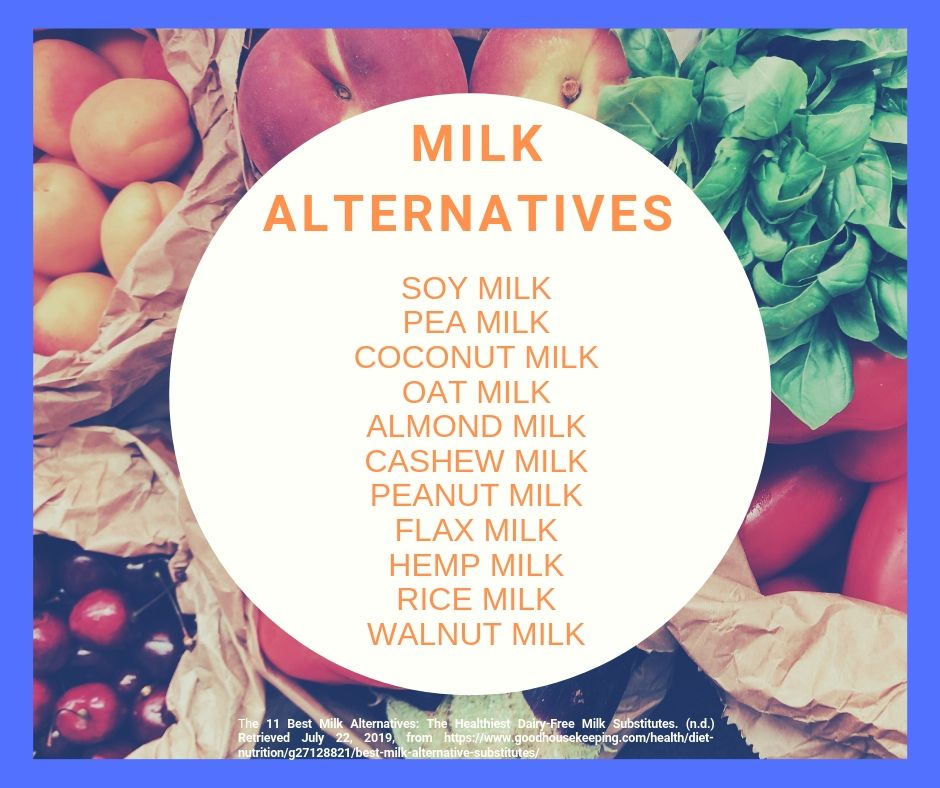
Five Course Discourse Suggestions
When hosting your dinner party and you discover one or more of your guests has a milk allergy you need to be prepared with alternatives for dessert. You won’t be able to use any butter, caramel, custard, or cream. A safe alternative is to find dessert recipes that are vegan. Veganism is derived from vegetarian; however, vegans exclude meats, eggs, diary products and all animal derived ingredients from their diet. Therefore, vegan recipes work great for those suffering from milk allergies. A list of vegan milk alternatives are presented in the graphic above.
The following are websites that provide Vegan dessert options:
- Good Housekeeping (https://www.goodhousekeeping.com/food-recipes/dessert/g5119/easy-vegan-dessert-recipes/)
- Food Network (https://www.foodnetwork.ca/healthy-eating/photos/10-vegan-desserts-that-even-non-vegans-will-love/#!600×400-no-bake-keto-fat-bombs)
- Minimalist Baker (https://minimalistbaker.com/28-best-vegan-desserts/)
Sources:
Milk & Dairy Allergy. (2015, January 12). Retrieved June 28, 2019, from ACAAI Public Website website: https://acaai.org/allergies/types-allergies/food-allergy/types-food-allergy/milk-dairy-allergy
Milk Allergy | Food Allergy Research & Education. (n.d.). Retrieved June 28, 2019, from /common-allergens/milk-allergy
Milk allergy – Symptoms and causes. (n.d.). Retrieved June 28, 2019, from Mayo Clinic website: https://www.mayoclinic.org/diseases-conditions/milk-allergy/symptoms-causes/syc-20375101